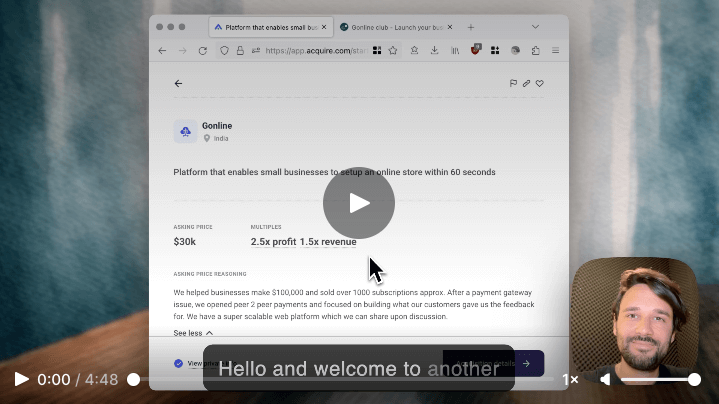3 Things I Started Working on Right After the Pixel Acquisition

After the Pixel acquisition was finalized about two weeks ago, I started working on what I deemed the three most important tasks.
Generally speaking, for founders who work on a business for many years, it’s easy to develop tunnel vision when it comes to the product they are building.
When someone not related to their business now looks at the product with fresh eyes, new ideas and improvements immediately come up.
In my experience, this holds true whether I evaluate a business for Waterglass or as a service to other funds.
With this in mind, let’s take a look at the three things I immediately started working on in the first two weeks after I acquired Pixel.
1. Fix the 404 page
While going through the documents during the due diligence process, I discovered a small detail in the referrer section of the user metrics.
A pretty relevant number of visitors were landing on the 404 page. In fact, close to 25% of all visitors encountered a 404 page when visiting pxl.to and more than 10% of all signups can be attributed to it.
For a link builder like Pixel, encountering 404 errors is fairly normal: old links may have been taken offline, free users who created and distributed links might not have signed up, or visitors could have mistyped a link.
After I understood the importance of the 404 page for Pixel, I started thinking how it could be improved.

Since Pixel is built using popular design frameworks, it was pretty straight forward to update the design and add a clear call-to-action (CTA) to the 404 page.

Once the button was tracked as a goal conversion (404Button), it immediately started showing up in the analytics.

404Button clicksI think the new 404 page can still be further improved and tested, but as a first step and quick win, it will do the trick.
2. Create an admin dashboard
In my previous businesses, working on anything related to internal dashboards was consistently pushed back by the team to yet another week.
Every. Single. Time.
We would never start working on it, but instead focus on anything that delivered immediate value to users. When it comes to metrics, we would just write and execute SQL queries for basic operations.

The reality is that you are flying blind if you don’t know what’s happening inside your product, and I can't stress enough how important it is to have data easily accessible.
This is why I decided to implement a proper admin dashboard right from the start. While version one is still simple, it already serves an important purpose.
For example, I now understand that we have double-digit signups daily, but the conversion rate is not where I would like it to be. Or that Pixel has hundreds of thousands of interactions on a daily basis.
With this in mind, the first goal is to fully understand how users are interacting with the product. Getting new users to an 'Aha!' moment as soon as possible is among my next priorities to increase the signup-to-paid conversion rate (CVR).
3. Add social proof like there is no tomorrow
We are social animals. We actively seek for information from our peers to make the right decision day in and day out, especially when it comes to buying new products and services.
Pixel is in the fortunate position to already have thousands of users who really, really like the product.
So it's time to let the world now.
Especially the Microsite feature has been perceived very well, with close to 1k being created to date (now guess where I got this number from).
Microsite is short for micro website and as the name suggests, it's a drag'n'drop website builder to show visitors information, capture data, or link to other websites.
Below are quotes from Pixel users:
I made a microsite and QR, it's really awesome, I can customize it as I want, it looks cool, I'm impressed.
This is the best bio link [microsite] I've ever tried. Even though there are few templates, I can customize it myself. I hope that in the future professional and cool templates will be added , and also e-commerce templates.
Microsite: Simple and easy to add to your subdomain when you are working on pxl.
This feedback is also reflected on Capterra, Product Hunt and Trustpilot, leading to great ratings across the board.

Adding even more social proof by showing publicly available avatars is a great way to confirm that real people are using the product and get value from it.
To be honest, I add social proof everywhere I can.
On landing pages. On signup pages. In most of the emails. Hell, I'm even thinking about adding social proof to invoices:
I love paying for Pixel! 10/10 will do again. Will not churn. Pinky promise!
(just kidding)
To sum it up, there is no stronger signal than real people having real opinions about what you are building. If they are positive, let everyone know. If not, start fixing the underyling problems.
What's coming next
The next tasks will be a bit more complex to work on. Overall, the goal is to double down on what’s working, understand what’s needed, and ship it.
One of these ideas the team and I started working on is related to AI and Microsites. It will be spun out as a standalone lead magnet under its own domain, but remain closely related to Pixel.
Can you guess what it will be?
PS: I'm doing weekly deal reviews where I analyze businesses based on data they provide in for sale listings. Videos are typically 4-6 minutes long. I post them on LinkedIn and on this publication tagged as Waterglass Deal Reviews.
